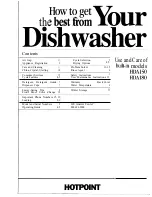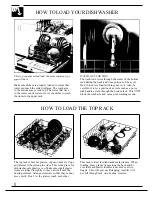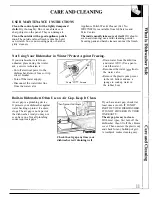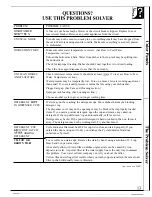
PROBLEM SOLVER
(continued)
PROBLEM
SPOTS AND
ON
GLASSES
CLOUDINESS ON
OF
POSSIBLE CAUSE
Spotting can
by these things:
●
Extremely hard water, (See How to Choose and Use Detergent section.)
●
Low
inlet water temperature. (See How to Test Water Temperature section.)
●
Overloading the dishwasher.
●
Improper loading. (See Loading section.)
●
Old
or damp powder detergent.
●
Phosphate level in detergent too low. (See How to Choose and Use
Detergent section.)
●
Rinse agent dispenser empty, (See
to Use a Rinse Agent section.)
●
Too
detergent. (See How to Choose and Use Detergent section.)
Local
water conditions and personal preferences vary. Try several brands of
detergents find one that gives the best results for you. A liquid dishwasher
detergent may help reduce filming.
To remove stubborn
from glassware:
1.
Remove all metal utensils from the dishwasher.
2. Do not add detergent.
3. Select
WASH cycle.
4. Start the dishwasher and allow to run for 18 to 22 minutes. The dishwasher will
now be in the main wash.
5. Then open the door and pour 2
cups
(500
ml) of white vinegar into the bottom of
the dishwasher.
6. Close the door and allow to complete the cycle.
doesn’t work:
as above, except use 1/4 cup (60 ml) of citric
acid crystals instead of
(Most drugstores carry citric acid crystals. If yours
doesn’t,
GE Factory Service.)
a vinegar or citric acid crystal rinse more than twice a month? Consider a home
water softener.
vinegar or
acid crystal rinse doesn’t work, the cloudiness is “etching.”
The
cannot be removed.
can be prevented:
Use less
detergent you have soft water. Wash glassware
the shortest cycle that will get them
Water temperature entering dishwasher exceeds
Rough handling can cause chipping. Load with care.
Make sure glassware and china
are secure and can’t
loose. (See Loading section.) Make sure
glasses and
stemware will clear the top of the tub when you push the rack into the dishwasher.
Always use the top rack for delicate items.
14
Summary of Contents for HDA150
Page 16: ...NOTES 16...
Page 17: ...NOTES 17...






































